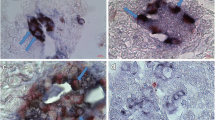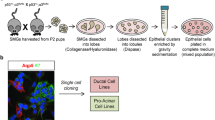Abstract
This study was conducted to determine whether intercalated duct cells in the rat parotid gland have the properties of tissue stem cells. After induction of cellular proliferation by repeated administration of isoproterenol (IPR), a β-adrenergic agonist, proliferation activity in acinar, intralobular, and intercalated ductal cells was quantified using Ki-67 immunohistochemistry. The total number of each type of component cell in a gland was also estimated in the course of IPR treatment. IPR was found to induce proliferation of acinar and intercalated duct cells, but not intralobular duct cells. The total number of acinar cells in a gland on day 5 of IPR treatment was 1.6 times of that at day 0 (baseline). In contrast, the total numbers of intercalated and intralobular duct cells did not change from baseline, indicating a high possibility that the proliferated intercalated duct cells differentiated into acinar cells. On days 2 to 3 of IPR treatment, intercalated duct cells with amylase-positive secretory granules were recognized in a region very close to the acini, and were suspected of being transitional cells from intercalated duct to acinar cells. This quantitative study indicates that intercalated duct cells may have the properties of tissue stem cells upon IPR stimulation.






Similar content being viewed by others
References
Barka T (1965) Induced cell proliferation. The effect of isoproterenol. Exp Cell Res 37:662–679
Barka T (1970) Further studies on the stimulation of deoxyribonucleic acid synthesis in the submandibular gland by isoproterenol. Lab Invest 22:73–80
Barka T, van der Noen H (1976) Stimulated growth of submandibular gland. Lab Invest 35:507–514
Burford-Mason AP, Cummins MM, Brown DH, MacKay AJ, Dardick I (1993) Immunohistochemical analysis of the proliferative capacity of duct and acinar cells during ligation-induced atrophy and subsequent regeneration of rat parotid gland. J Oral Pathol Med 22:440–446
Dardick I (1998) Mounting evidence against current histogenetic concepts for salivary gland tumorigenesis. Eur J Morphol 36(suppl):257–261
Dardick I, Aileen P, Burford-Mason AP (1993) Current status of histogenetic and morphogenetic concepts of salivary gland tumorigenesis. Crit Rev Oral Biol Med 4:639–677
Denny PC, Denny PA (1993) DNA synthesis and cell division. In: Dobrosielski-Vergona K (ed) Biology of the salivary glands. CRC Press, Boca Raton, pp 263–281
Denny PC, Chai Y, Klauser DK, Denny PA (1990) Three-dimensional localization of DNA synthesis in secretory elements of adult female mouse submandibular gland. Adv Dent Res 4:34–44
Hand AR, Ho B (1985) Mitosis and hypertrophy of intercalated duct cells and endothelial cells in the isoproterenol-treated rat parotid gland. J Dent Res 64:1031–1038
Hand AR, Sivakumar S, Barta I, Ball D, Mirels L (1996) Immunocytochemical studies of cell differentiation during rat salivary gland development. Eur J Morphol 34:149–154
Iatropoulos MJ, Williams GM (1996) Proliferation markers. Exp Toxic Pathol 48:175–181
Kerstens HM, Poddinghe PJ, Hanselaar AG (1995) A novel in situ hybridization signal amplification method based on the deposition of biotinylated tyramide. J Histochem Cytochem 43:347–352
Korsrud FR, Brandtzaeg P (1982) Characterization of epithelial elements in human major salivary glands. J Histochem Cytochem 30:657–666
Leblond CP (1964) Classification of cell populations on the basis of their proliferative behaviour. Natl Cancer Inst Monogr 14:119–145
Radley JM (1969) Ultrastructural changes in the rat submaxillary gland following isoprenaline. Z Zellforsch Mikosk Anat 97:196–211
Redman RS (1995) Proliferative activity by cell type in the developing rat parotid gland. Anat Rec 241:529–540
Roosen-Runge C, Leik J (1968) Gonocyte degeneration in the postnatal male rat. Am J Anat 122:275–300
Schneyer CA, Finley HW, Finley SC (1967) Increased chromosome number of rat parotid cells after isoproterenol. Proc Soc Exp Biol (NY) 125:722–728
Schwarts-Arad D, Arber L, Alber N, Zajicek M, Michaeli Y (1988) The rat parotid gland- a renewal cell population. J Anat 161:143–151
Tanaka T, Gresik EW, Barka T (1981) Immunocytochemical localization of amylase in the parotid gland of developing and adult rats. J Histochem Cytochem 29:1189–1195
Tandler B, Nagato T, Toyoshima K, Phillips CJ (1998) Comparative ultrastructure of intercalated ducts in major salivary glands: a review. Anat Rec 252:64–91
Van den Brenk HAS, Sparrow N, Moore V (1970) Effect of X-ray irradiation on salivary gland growth in the rat. II. Quantitative studies on sialoadenotrophism induced with isopropylnoradrenaline and its modification by single doses of X-rays. Int Radiat Biol 17:135–161
Vugman I, Hand AR (1995) Quantitative immunocytochemical study of secretory protein expression in parotid glands of rats chronically treated with isoproterenol. Microsc Res Technol 31:106–117
Yu CCW, Woods AL, Levison DA (1992) The assessment of cellular proliferation by immunohistochemistry: a review of currently available methods and their application. Histochem J 24:121–131
Zajicek G, Ygil C, Michael Y (1985) The streaming submandibular gland. Anat Rec 213:150–158
Zajicek G, Schwartz-Arad D, Arber N, Michaeli Y (1989) The streaming of salivary gland II: parenchyma and stroma advance at the same velocity. Cell Tissue Kinet 22:343–348
Acknowledgments
The authors are grateful to Ms Aya Nakagawa of Kitasato University School of Medicine for her kind assistance in editing this manuscript. This research was supported by a Grant-in-aid for Scientific Research from the Japan Society for the Promotion of Science (no. 18590196).
Author information
Authors and Affiliations
Corresponding author
Rights and permissions
About this article
Cite this article
Katsumata, O., Sato, YI., Sakai, Y. et al. Intercalated duct cells in the rat parotid gland may behave as tissue stem cells. Anat Sci Int 84, 148–154 (2009). https://doi.org/10.1007/s12565-009-0019-0
Received:
Accepted:
Published:
Issue Date:
DOI: https://doi.org/10.1007/s12565-009-0019-0




